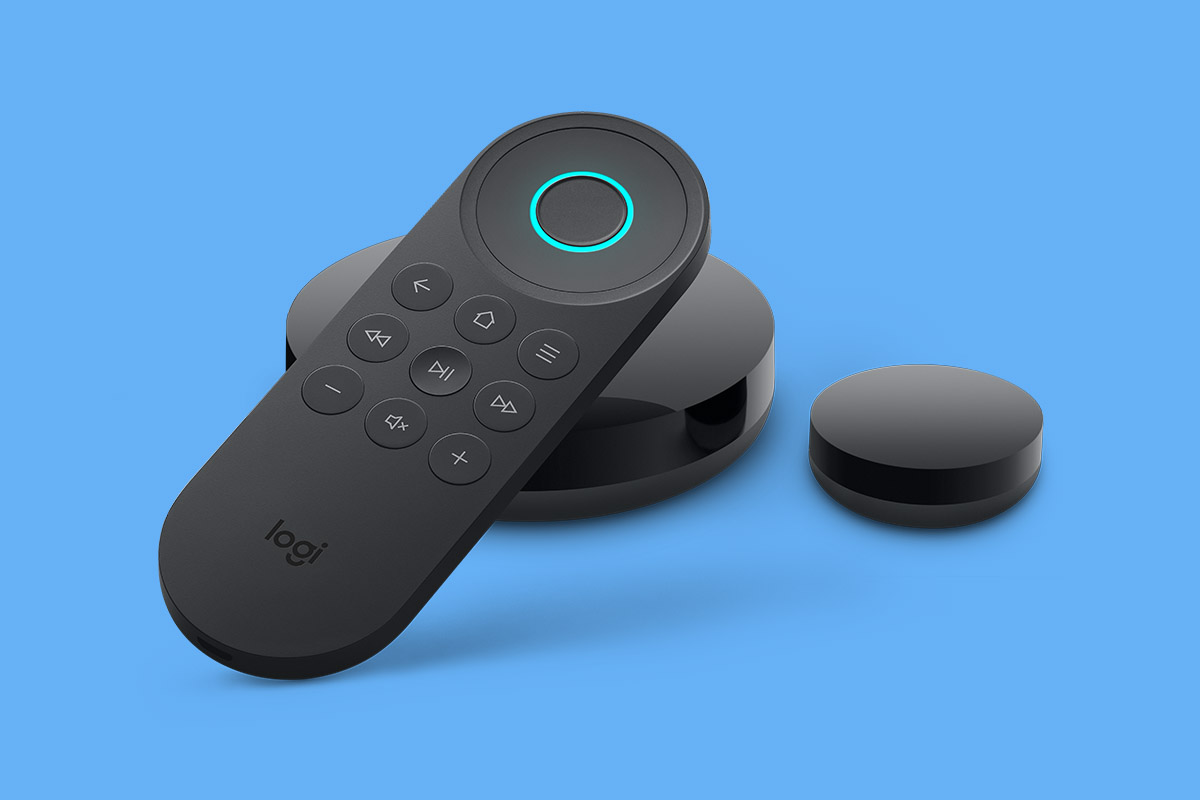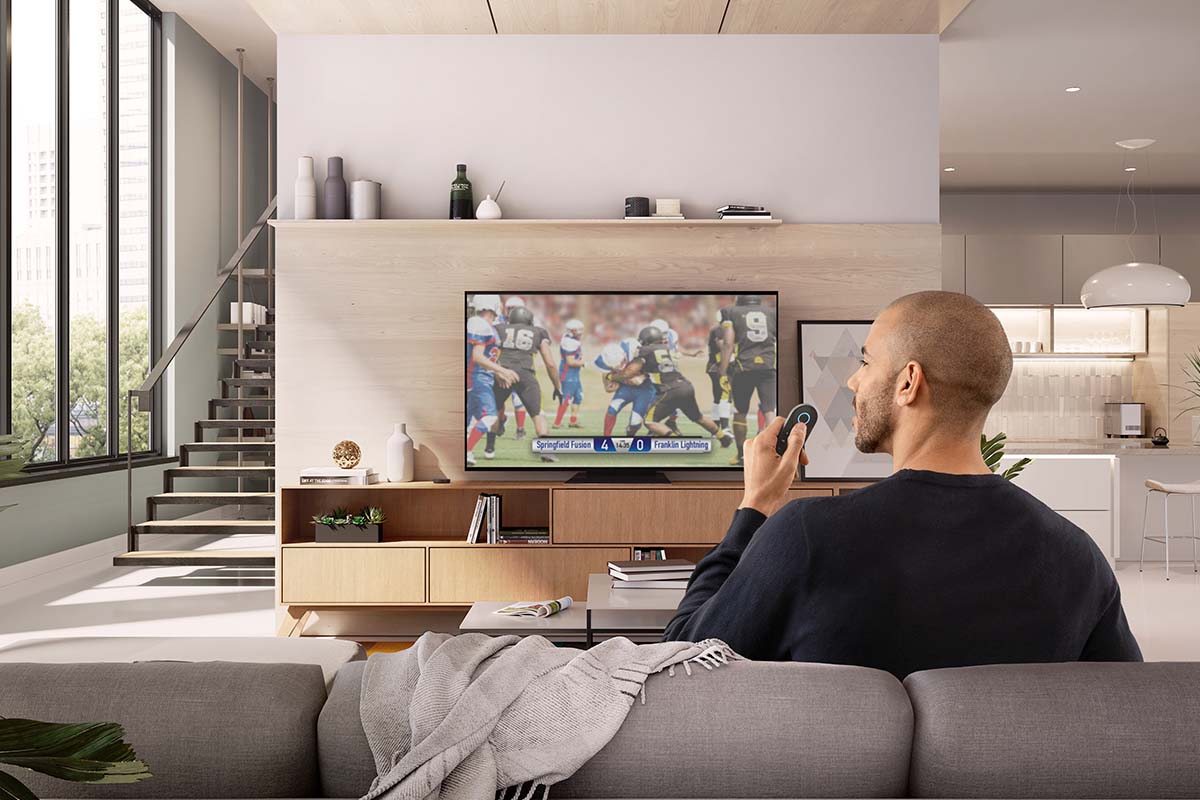Nota bene: If you buy through the links in this article, we may earn a small share of the profits.
Logitech recently introduced the Harmony Express, a minimalist universal remote that works primarily via Alexa commands. Ideally, it could replace up to 15 remotes and works with somewhere around 250,000 devices.
Ideally.
Let’s start with the good news: “Minimalist” is the keyword here — the Express features one large “OK” button for accessing voice commands that doubles as a touchpad for navigating around screens. There are also nine smaller buttons to change channels, mute and pull up menus, all easily identifiable. No separate touchscreen, no number buttons, no confusion.
Purely on design alone, this is the most straightforward universal remote ever made. Still, that means nothing if it doesn’t do what it promises: marrying all your devices together into one simple-to-use handheld.
We tested the Logitech first in an apartment where Logitech had already setup the remote with various A/V equipment, and then again where we set it up at home using the included instructions.
The setup:
Let’s start by saying the remote worked flawlessly in the setup Logitech laid out, so my issues may be unique to my home situation. In a fairly narrow living room, I placed the included blaster and mini-blaster receivers within inches of my media equipment, which included a 65” LG HDTV (2018 model), an Altice One cable box/DVR/router, Playstation 4, Sonos Beam (with two linked Sonos Ones) sound system and an Xbox One.
Setup was supposed to take 15 minutes, and the process was both faster and slower than expected. The Express app “found” three of my four devices immediately and only stumbled on the Playstation — for devices the app doesn’t discover, you’re supposed to type in the brand and model number (always fun to find) and hope things match up. But a few attempts and one quick Google inquiry helped me get the PS4 under the Harmony umbrella.

What works:
At first (see below), voice commands and directional taps on the remote’s central OK button got me what I needed — in particular, channels (“go to channel 11” and “go to ESPN”) and app launches (“Launch Netflix app”).
I thought pairing the devices with the right HDMI inputs was going to involve a peek behind the TV or scrounging underneath my cable box looking for a model number. Instead, I never had to leave my couch.
The hidden pleasure of the Harmony Express actually lies in its portable Alexa abilities. Except for music, the remote can replicate Alexa commands at the push of the OK button, without having to say “Alexa.” So you can set timers, check weather and ask general questions without worrying about a device always being on and listening.
The remote will apparently last one month on a single charge, and you can use your app to find it if it’s lost, much like a Tile (there’s a quite loud alert it’ll send out).
Aesthetically, the Harmony is quite unobtrusive — the small, shiny black disc isn’t going to stand out from any other device in your living room.

What needs work:
Things got more complicated when I tried to access apps from different devices — for example, I wanted my Netflix app pulled up from my Altice One box, not my smart TV, as it’s a slightly better experience. While this was showcased in the original Logitech demo, I was unable to duplicate this setup at home. Apparently a lot of this is customizable via the app, but figuring this out wasn’t intuitive.
Connectivity was another issue. I had to reboot my Express a few times during the initial use, and each time it became less responsive when I was finally able to pair it back up.
In what might have been user error, I used my original remotes during a few frustrating moments, which seemed to cause some syncing issues. Logitech really wants you to make Express your central control.
I had much better luck at the Harmony Express demo, though both there and at home there was a small but noticeable delay when issuing voice commands and the proper device responding.
One quick note:
Outside of the above-mentioned A/V, I have no other smart home devices, but the Express will supposedly sync with assorted smart lights and thermometers. A list of devices the Harmony can work with is available here.
What others are saying:
- “It’s not the be-all, end-all of universal remote controls, but it’s plenty powerful for most people’s needs.” — TechHive
- “I’m very confused about who is going to buy this product. I get the concept and who it’s for: people who want a universal remote that’s not overly complex. But… $250?” — The Verge
- “Logitech makes some of the best universal remotes, but unfortunately, the Express doesn’t rise to their level.” — Tom’s Guide
- “An attractive and useful universal remote, but that isn’t quite enough to justify its $250 price.” — PC Mag
Recommendation:
Your use of the Harmony will entirely depend on your home theater arrangement and how willing you are to learn new or additional voice commands. This isn’t a remote for the A/V enthusiast, but based on first impressions, it’s not quite plug-and-play either. Soon after installing, I found myself gravitating back to my cable company’s remote (which takes voice commands) and the Alexa on my Sonos, which pretty much solved 80% of my home entertainment requirements.
We've put in the work researching, reviewing and rounding up all the shirts, jackets, shoes and accessories you'll need this season, whether it's for yourself or for gifting purposes. Sign up here for weekly style inspo direct to your inbox.


















